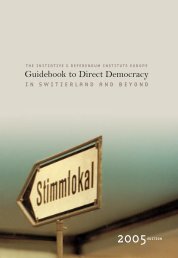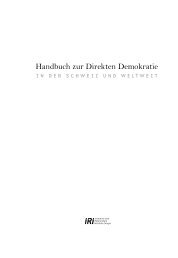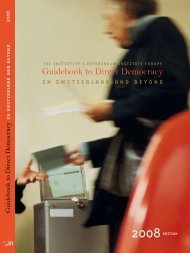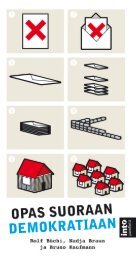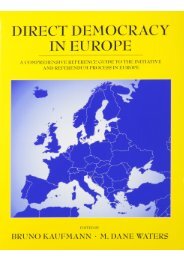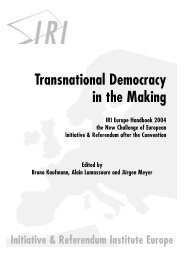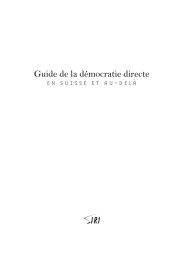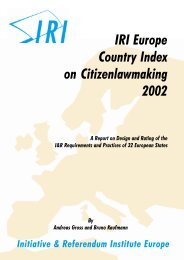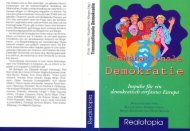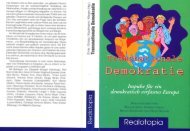Initiative & Referendum Monitor 2004/2005
The IRI Europe Toolkit for Free and Fair Referendums and Citizens’ Initiatives
The IRI Europe Toolkit for Free and Fair Referendums and Citizens’ Initiatives
You also want an ePaper? Increase the reach of your titles
YUMPU automatically turns print PDFs into web optimized ePapers that Google loves.
Comment: <strong>Monitor</strong>ing referendums –<br />
a challenging task<br />
Even if it is difficult to establish precise<br />
guidelines for assessing referendums and<br />
elections wherever they occur, it is still<br />
possible to establish some analytical<br />
distinctions. If we consider the two main<br />
dimensions of freedom and fairness, it<br />
seems evident that some referendums can<br />
be characterized as free and fair or at least<br />
acceptable, even if they are not perfect.<br />
All, or almost all, elections and referendums<br />
in well-established democracies presumably<br />
fit this description. Of course, it is also clear<br />
that some elections and referendums are<br />
not “free and fair” owing to the violation<br />
of a large number of key criteria, but such<br />
elections and referendums are scarcely to be<br />
found in Europe. Between these two<br />
extremes, however, there are a number of<br />
cases in which elections and referendums<br />
cannot be labelled “free and fair” because<br />
of any number of shortcomings, but in<br />
which it would be unreasonably explicit to<br />
declare them not “free and fair”. Perhaps<br />
they are free in a formal sense, but fairness<br />
is limited in practice - for instance, because<br />
of a very unequal distribution of resources -<br />
or perhaps they are free only to some<br />
extent, but fairly conducted within those<br />
particular limits. For referendums, in<br />
particular, freedom may vary among<br />
European countries because of more or less<br />
governmental control concerning the timing<br />
and the issue of the popular vote. When the<br />
full circumstances are taken into account<br />
and a broad view is adopted - especially in<br />
terms of the possibility of progress towards<br />
greater political competition and<br />
participation - it may be deemed that<br />
elections and referendums are<br />
“acceptable”, even if they fall short of<br />
being completely “free and fair”. These are<br />
not only the most difficult cases to assess,<br />
but also the ones that international<br />
observers are most likely to witness, since<br />
the governments in these countries are<br />
eager to obtain the international<br />
community’s stamp of approval as a means<br />
of boosting their internal legitimacy and<br />
garnering external recognition. In practice,<br />
then, elections and referendums are most<br />
likely to fall within the shaded area<br />
(between curves a and c) of the table below<br />
i.e. neither entirely free and fair nor<br />
entirely unfree and unfair, but acceptable<br />
when technical limitations and prospects<br />
for progress towards democracy are taken<br />
into consideration.<br />
Table5: Identifying Free and<br />
Fair <strong>Referendum</strong>s<br />
a b<br />
- Free +<br />
c<br />
In these cases, analysis of the application of<br />
a country’s election law should take into<br />
account not only the criteria listed in table<br />
5, but also other factors that may help<br />
observers determine how strictly those<br />
criteria should be applied. Even under more<br />
favourable conditions, it is neither<br />
reasonable nor methodologically feasible to<br />
insist on complete fulfilment of all the<br />
criteria before declaring an election or a<br />
referendum “free and fair”. Something less<br />
(e.g. curve c) may suffice, as long as basic<br />
freedoms exist, the election law is for the<br />
most part applied impartially, and the main<br />
competitors have reasonable access to<br />
campaign resources and the media.<br />
+<br />
Fair<br />
-<br />
Given the prevalence of elections and<br />
referendums that fall within the shaded<br />
area (between curves a and c), these special<br />
considerations deserve close attention.<br />
Because of the difficulty of distinguishing<br />
clearly between the dimensions of “free”<br />
and “fair”, assessments of such ballots can<br />
be represented by a straight line connecting<br />
the two most extreme points (the diagonal<br />
line in the table). Thus the crucial point is<br />
where the diagonal leaves the shaded area<br />
(in a south-western direction): here we will<br />
find the threshold between “acceptable”<br />
and “not acceptable”.<br />
Free and fair?<br />
The phrase “free and fair” cannot denote<br />
compliance with a fixed, universal standard of<br />
electoral competition: no such standard<br />
exists, and the complexity of the electoral<br />
process makes the notion of any simple<br />
formula unrealistic. Election observation<br />
requires the simultaneous use of multiple<br />
scales to achieve valid and reliable<br />
measurements of complex phenomena. In<br />
particular, these problems affect the large<br />
segment of elections which are neither clearly<br />
free and fair nor clearly unfree and unfair.<br />
Election and referendum observers,<br />
therefore, face a dilemma. They could<br />
simply avoid using the phrase “free and<br />
fair”, but this would run the risk of opening<br />
the door to its use by others with less<br />
knowledge or understanding of the<br />
situation. Alternatively, observers can<br />
choose to use the phrase as a convenient<br />
shorthand, but at the cost of exposing<br />
themselves to all manner of criticism<br />
grounded in intellectual or moral<br />
considerations.<br />
This does not mean, however, that election<br />
and referendum observation and assessment<br />
are hopeless tasks. It is undoubtedly possible<br />
to draw general conclusions about how best<br />
to conduct such activities. In the borderline<br />
cases described above - the crucial “inbetween”<br />
category - observers should<br />
identify their evaluation criteria as clearly as<br />
possible while at the same time<br />
acknowledging that their conclusions rest to<br />
some degree on estimates and subjective<br />
judgments. In relation to referendums in<br />
Europe, particular attention has to be given<br />
to the extent to which the government<br />
controls the event. This applies to the<br />
control over when a referendum is called,<br />
the issue under discussion, and the manner<br />
in which public funds are shared among<br />
competing sides. (PS)<br />
Note: this comment is an extract from a<br />
working paper written by Palle Svensson<br />
and presented at the IRI <strong>Referendum</strong><br />
<strong>Monitor</strong>ing Conference in Tartu / Estonia<br />
(September 2003). The full version can be<br />
found in the <strong>Initiative</strong> & <strong>Referendum</strong><br />
<strong>Monitor</strong> Section at www.iri-europe.org.<br />
24<br />
25



